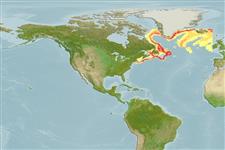Common names from other countries
Elasmobranquios (tiburones y rayas) (sharks and rays) >
Rajiformes (Skates and rays) >
Rajidae (Skates)
Etymology: Amblyraja: Greek, amblys = darkness + Latin, raja, -ae = ray (Raja sp.) (Ref. 45335).
Issue
Provisionally retained as valid but treated as junior synonym of A. hyperborea by Weigmann (2016, Ref. 106604) due to strong morphological similarity and preliminary molecular data. Further work is needed to resolve this issue (Ref. 118749).
Environment: milieu / climate zone / depth range / distribution range
Ecología
marino batidemersal; rango de profundidad 165 - 3000 m (Ref. 114953). Deep-water; 67°N - 39°N, 72°W - 10°W (Ref. 114953)
Western Atlantic: Nova Scotia, Canada to southern New England, USA; Eastern Atlantic: Iceland (Ref. 12462); North Atlantic: Labrador Sea and off British Isles (Ref. 114953)
Tamaño / Peso / Age
Maturity: Lm ? range ? - ? cm
Max length : 74.3 cm TL macho / no sexado; (Ref. 4926); 85.0 cm TL (female)
Short description
Claves de identificación | Morfología | Morfometría
Lacks large thorns on anterior margins and mid posterior parts of pectorals and on either side of mid-dorsal ridge on the disc. Upper surface plain light brown, either grayish or of chocolate hue, darker along margins of fins. Lower surface brownish gray, grayish white or perhaps pure white (Ref. 6902).
Benthic (Ref. 58426). Deep-water species. Prefers higher temperatures. Feeds on small fishes and crustaceans (Ref. 6902). Oviparous (Ref. 50449). Eggs have horn-like projections on the shell (Ref. 205). Maximum depth reported taken from Ref. 117245. It may be captured as by-catch in deep water fisheries, but due to its depth preference, it is less likely to be vulnerable (Ref. 117245).
Life cycle and mating behavior
Maturities | Reproducción | Spawnings | Egg(s) | Fecundities | Larva
Oviparous, paired eggs are laid. Embryos feed solely on yolk (Ref. 50449). Eggs have horn-like projections on the shell (Ref. 205).
McEachran, J.D. and K.A. Dunn, 1998. Phylogenetic analysis of skates, a morphologically conservative clade of elasmobranchs (Chondrichthyes: Rajidae). Copeia 1998(2):271-290. (Ref. 27314)
IUCN Red List Status (Ref. 130435)
CITES (Ref. 128078)
Not Evaluated
Threat to humans
Harmless
Human uses
Herramientas
Special reports
Download XML
Fuentes de Internet
Estimates based on models
Preferred temperature (Ref.
115969): 3.1 - 4, mean 3.6 (based on 69 cells).
Phylogenetic diversity index (Ref.
82804): PD
50 = 0.5010 [Uniqueness, from 0.5 = low to 2.0 = high].
Bayesian length-weight: a=0.00302 (0.00141 - 0.00645), b=3.24 (3.07 - 3.41), in cm Total Length, based on LWR estimates for this (Sub)family-body shape (Ref.
93245).
Nivel trófico (Ref.
69278): 3.7 ±0.57 se; based on food items.
Resiliencia (Ref.
120179): Bajo, población duplicada en un tiempo mínimo de 4.5-14 años (Fec assumed to be <100).
Fishing Vulnerability (Ref.
59153): Moderate to high vulnerability (54 of 100).
